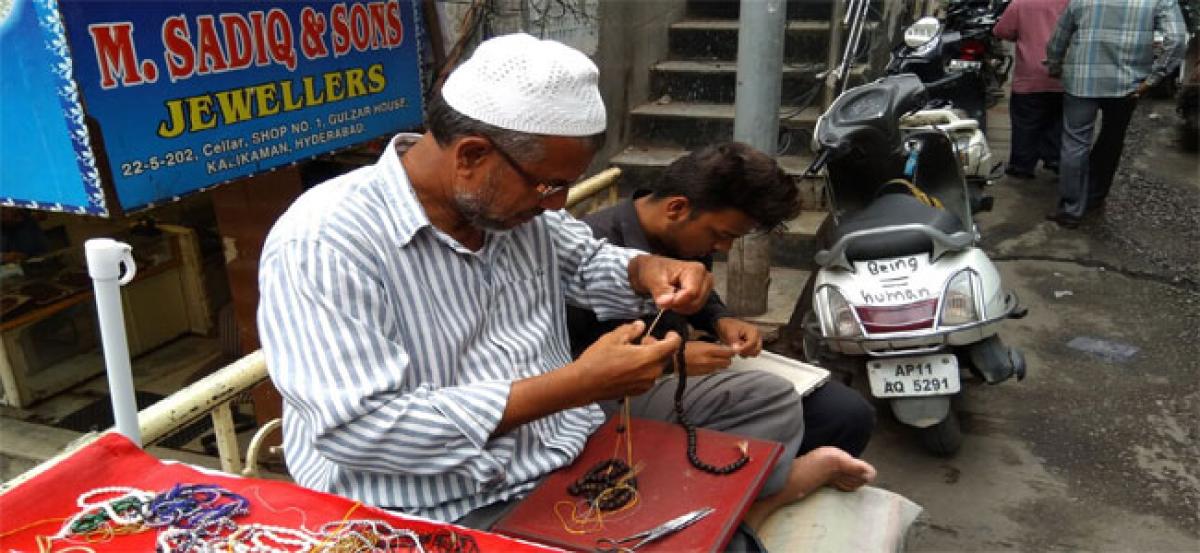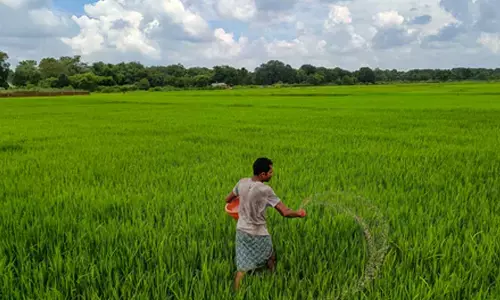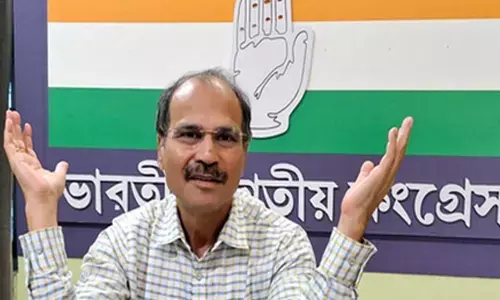‘Patwaikars’ keep alive tradition of handmade mangalsutras

The roadside craftsmen in Old City continue to keep alive the ageold practice of tailor made Latchha or Mangalsutra for women, who adorn it as a symbol of being married In the age of modern technology, where everything is machine made, the only market of Patwaikar or latchha ghatane wala is backed by the robust jewellery market in Gulzar Houz
Gulzar Houz: The roadside craftsmen in Old City continue to keep alive the age-old practice of tailor made Latchha or Mangalsutra for women, who adorn it as a symbol of being married. In the age of modern technology, where everything is machine made, the only market of ‘Patwaikar’ or ‘latchha ghatane wala’ is backed by the robust jewellery market in Gulzar Houz.
These Patwaikars at Gulzar Houz near Charminar have been serving the women customers since Nizam’s period and the location remains famous for jewellery business of all kind. Md Rasheed Ahmed, 62-year-old craftsman, working for more than three decades, said that this Patwaikar works remains tailor-made and because of the artistic value with manual work without using a machine satisfies the customers. According to him, even the big jewellery shops handover work orders to them, which helps them sustain. “The making of latchha, mangalsutra with black beads (kali poth) is a transformation of loose beads, sometimes with crystals and pearls. There are many varieties and shapes of these beads which start from size of a small ant to a size of a pearl. For this work, threads are also used like zari, reshmi and tangus which come in many colours and size,” said Rasheed.
The chain of beads is made by using a needle, thread and wax. In this exercise, the craftsmen not only use hands but their legs. By catching up the thread, with the help of their toes, similar to garland maker, these craftsmen come with fascinating designs. The process involves catching up one side of the thread in a toe, while the other side used for inserting the beads with the help of needle. The wax is used for increasing the strength of thread. This process continues until the entire chain of beads is completed and tied with a zari thread in the end.
Md Ghouse, also working for almost three decades said that he was working since he was 8-year-old. “This is only market for Patwaikar workers and some are present in shops and showrooms itself. For making latchha or mangalsutra, it depends on its size and length and it costs a minimum of Rs150 per piece,” he said. V B Gulzar Houz: The roadside craftsmen in Old City continue to keep alive the age-old practice of tailor made Latchha or Mangalsutra for women, who adorn it as a symbol of being married. In the age of modern technology, where everything is machine made, the only market of ‘Patwaikar’ or ‘latchha ghatane wala’ is backed by the robust jewellery market in Gulzar Houz.
These Patwaikars at Gulzar Houz near Charminar have been serving the women customers since Nizam’s period and the location remains famous for jewellery business of all kind. Md Rasheed Ahmed, 62-year-old craftsman, working for more than three decades, said that this Patwaikar works remains tailor-made and because of the artistic value with manual work without using a machine satisfies the customers. According to him, even the big jewellery shops handover work orders to them, which helps them sustain. “The making of latchha, mangalsutra with black beads (kali poth) is a transformation of loose beads, sometimes with crystals and pearls. There are many varieties and shapes of these beads which start from size of a small ant to a size of a pearl. For this work, threads are also used like zari, reshmi and tangus which come in many colours and size,” said Rasheed.
The chain of beads is made by using a needle, thread and wax. In this exercise, the craftsmen not only use hands but their legs. By catching up the thread, with the help of their toes, similar to garland maker, these craftsmen come with fascinating designs. The process involves catching up one side of the thread in a toe, while the other side used for inserting the beads with the help of needle. The wax is used for increasing the strength of thread. This process continues until the entire chain of beads is completed and tied with a zari thread in the end.
Md Ghouse, also working for almost three decades said that he was working since he was 8-year-old. “This is only market for Patwaikar workers and some are present in shops and showrooms itself. For making latchha or mangalsutra, it depends on its size and length and it costs a minimum of Rs150 per piece,” he said.
BY M M Farooqui

















